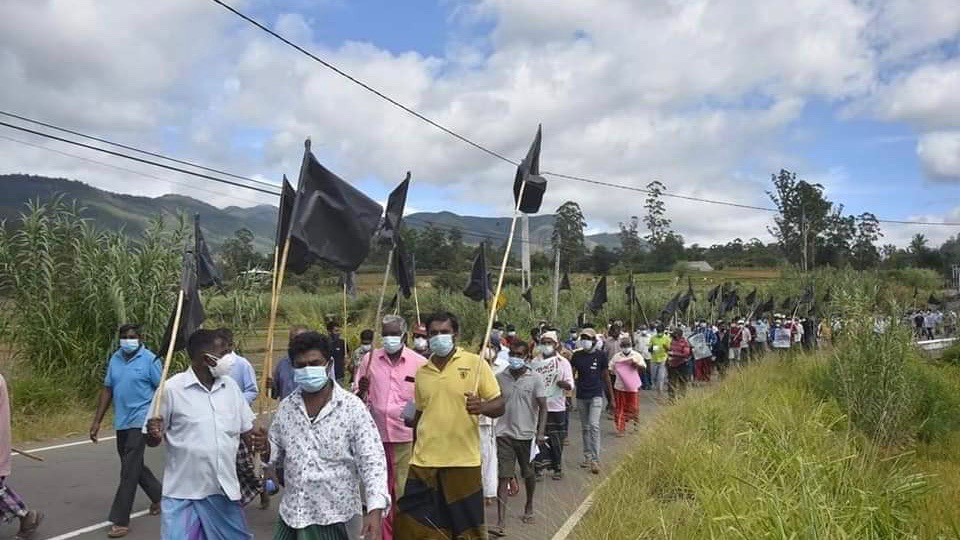Farmers in Dekatana district in the Western Province of Sri Lanka organized a protest march and burnt effigies of the agriculture minister on Wednesday, November 10, to demand fertilizer aid from the government which adopted a 100% organic farming policy earlier this year.
With the promised aid not forthcoming from the government’s end, the protesters called for a return to chemical fertilizers without which production of key export crops like tea and paddy is beginning to suffer, adding to the economic crisis the country has been going through.
On April 22, Sri Lankan president Gotabaya Rajapaksa announced a complete ban on the use and import of chemical fertilizers in order to make the country the “world’s first 100 percent organic food producer.” In the gazette notification, the government claimed that the use of fertilizers and agro-chemicals, however productive, was leading to “contamination of lakes, canals and rivers,” as well as spread of non-communicable diseases like “kidney disease”, which research has claimed to be related to fluoride presence in groundwater.
There are other reasons besides those cited by the government that have been held responsible for the dramatic turn of events. The country has been reeling under the pressure of its own debts for a long time and has reportedly been going through an acute foreign reserve shortage since the COVID-19 pandemic that has severely impacted the country’s major revenue sector – tourism. Cutting down on fertilizer expenditure has been perceived as a move towards saving foreign reserve expenditure.
Being a primarily import-dependent agricultural economy, the overnight shift to organic farming in May saw farmers struggling with the switch which is both “difficult and expensive.” The cultivating season for paddy which begins in October is projected to see a fall in production by at least 40%, according to a Reuters report.
Saman Dharmakeerthi, professor of soil and agriculture management at University of Peradeniya, who has been following the latest developments, believes the country might see a larger mobilization at the end of the Maha season in March-April with a significant fall in the supply of paddy.
The expected fall in paddy production this year has been echoed by other sectors of civil society as well. According to the survey-report of Colombo-based think tank Verité Research, which interviewed farmers over the telephone shortly after the ban came into effect, the highest dependency of chemical fertilizers is among paddy farmers (94%) followed by tea and rubber, which form the largest export-base of cash crops in the island nation.
A puritanical-style move to an organic model of farming has been spelled as “disaster” and “warning” to other developing countries.
Professor R. Ramakumar at the School of Development Studies, Tata Institute of Social Sciences, Mumbai, wrote on the ongoing crisis in Sri Lanka, “The irrational reduction in chemical inputs to agriculture even at low levels of productivity can spell disaster… Agricultural scientists have always been aware of the nutrient deficiencies of soil, as well as the perils of overuse of chemicals and the improper/imbalanced application of fertilizers. They therefore recommend location-specific solutions to nurture soil health and sustain increases in soil fertility.”
This is however not the first time that a country has decided to go fully organic in the region.
In 2013, Bhutan announced its plans to transition completely from conventional style agriculture to become 100% organic by 2020, receiving international attention for its efforts to reduce agricultural impact on the environment. However, studies have shown that the policy has seen a considerable fall in Bhutan’s GDP, welfare losses, and also a substantial impact on its food security. Many like Dharmakeerthi are concerned that Sri Lanka may be on the same path.
A letter signed by 141 agriculture academics forming the Sri Lanka Agriculture Economics Association (SAEA) noted that the policy has aggravated the economic situation as the government did not provide any strategy or plan of action in time and the farmers’ protests are a result of this.
Following widespread protests by farmers in October in the face of an ongoing economic emergency and rising food prices, the Rajapaksa government decided to withdraw the blanket ban on chemical fertilizers and allowed import of ammonia-based fertilizers in light of the falling production of tea – Sri Lanka’s top export crop which is valued at USD 1.3 billion annually.
The fertilizer ban has also stirred regional power equations following Sri Lanka’s claims that a Chinese firm, Qingdao Seawin Biotech Group Pvt. Ltd., sent a “contaminated batch” of organic fertilizers. Sri Lanka refused payment and the permit to unload cargo at its ports leading to further tension.
According to latest developments, on November 15, the Sri Lankan government decided to re-test the Chinese fertilizer consignment with a third-party as was announced by Chinese ambassador Qi Zhenhong.
Sri Lanka has distributed 100 tonnes of liquid nitrogen, nano fertilizers imported from India “which are essentially chemical fertilizers that contain urea,” says Dharmakeerthi.
The relaxations on the ban may have come a little too late as the cultivating season has already begun in Sri Lanka. He also adds, “One month into the cultivating season, farmers are only sowing paddy for their own consumption because there is not enough fertilizer-organic or chemical- to meet the requirements of pre-ban production levels….overall only 25% of the farmers are growing paddy so far.”





